I have observed mortars and light infantry guns firing HE at tanks frequently , this appears to be 99% ineffective and just wastes ammo plus reveals the position of the firing unit provoking retaliation. I would like ineffective fire be restricted to inexperienced / poorly trained units .
You are using an out of date browser. It may not display this or other websites correctly.
You should upgrade or use an alternative browser.
You should upgrade or use an alternative browser.
Dave 'Arjuna' O'Connor
Panther Games Designer
- Joined
- Jul 31, 2014
- Messages
- 3,416
- Points
- 113
- Location
- Canberra, Australia
- Website
- www.panthergames.com
Before I deem that ineffective fire is occurring for no good reason I need a save where this fire occurs so I can step through and confirm the mater.
Before I deem that ineffective fire is occurring for no good reason I need a save where this fire occurs so I can step through and confirm the mater.
Leave the mater (old british and latin word for mother?) alone ! Or is the gun in that scenario mating?
Just kidding....
.... btw, HL (hollow-charge) grenades were issued for le.IG 18 (starting around 1942) and s.IG 33 infantry guns (some time after the rounds for the IG 18), providing AT capabilities for these guns.
Various German sources and the German field manual from 1940, as well as Ian Hogg's book (2001), state that a le.IG 18 could destroy or knock out lightly arnored vehicles (eg. scout cars, and some lightly armored halftracks) with HE (!) grenades up to a distance of 300 meters (almost flat trajectory), if they were charging the gun's position (so that leaded aiming, which would have made a hit rather difficult, due to the low muzzle velocity, was not needed). Also, in direct fire mode, fixed enemy installations, like earth walls (say as parts of defensive perimeters) with thicknesses of up to 1 meter, could be penetrated with HE rounds.
In turn, the le.IG 18's hollow-charge grenade could penetrate up to 85mm of armor. The design of the HL-grenade was revised one or another time, afaik, and there are some hints that there was an over-calibre version (which could have been used in Africa, as there was a shortage of effective AT guns at an early stage of the campaign), that could have been used temporarily as stop-gap solution, but the HL-shell ("Hohlladung" = hollow charge present in a HEAT shell), which was introduced in 1942 and delivered to all theaters, was a regular 75-mm round that carried 5 kg of explosives and that looked like this (left: HE shell, right: HL shell):
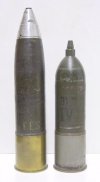
The penetration power was sufficient to combat enemy medium tanks in self-defense situations at short-medium ranges, where the gun position was attacked or threatened to be overrun, but the AT capability was also used during advances, if AT guns or tanks were not around, naturally, as these guns' range was pretty limited and as their role was to provide close fire support (in direct or indirect fire mode, with the main focus on indirect fire from concealed postions or terrain depressions) for the line infantry, anyways.
The le.IG 18 crews also had a special cartridge for indirect fire at their disposal, which was called "Sonderkartusche 6" ("special cartridge 6"), which must have been an additional powder cartridge (if I am not mistaken) that increased the effective amount of propellant charge, extending the range to 4,600 meters. !!! The round was also called "6th charge", which means that the higher amount of propellant charge would reduce the gun's "life span" dramatically, due to wear/tear of the barrel, so that crews were not allowed to use these cartridges for every shot, obviously, but - hence the name - on every 6th or maybe even every 10th shot, only.
I am guessing that a group of le.IG 18's fired a salvo of such rounds (means regular HE shells with that 6th-round powder cartridge) only to bridge the time frame other (closer) arty units (or units with higher effective ranges) needed to adjust their guns, so it cannot be seen as permanent extension of such gun's max range. I am not sure whether the cartridge was just added, or if the original cartridge could be removed and replaced by the "6th" cartridge. Pics of the cartridge (pic on the left) and its storage box (pic on the right):
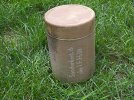
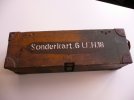
With the s.IG 33, 150-mm HE rounds (weight: 38 kg), HL-rounds (24.6 kg) and smoke grenades (same weight, afaik) could be fired. The HL-round (Hohlladungsgranate 39 HL/A) could penetrate up to 160 mm of armor (at 30 degrees?) according to German sources, other sources add that the muzzle velocity reached ~ 460 meters/second, which enabled gun crews to engage medium and even heavy enemy tanks at reasonable distances. I am not sure when the HL rounds for the s.IG 33 were issued, but very late 1942 or early 1943 may be a good guess, as that round was introduced "some time after" the HL-rounds for the le.IG 18, which were issued in 1942, according to German sources. The following picture (which I picked up on Flickr) shows a s.IG 33-crew loading a hollow-charge round. The picture may portray a training exercise performed for propaganda purposes (note, there's a little hill/slope in front of the position, which makes it impossible to fire at somewhat distant targets), or the crew really expects enemy tank units to crest that hill and attack the position (and they're in for surprising some enemy tanks):
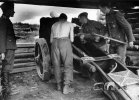
The landscape and the cabin (could be a makeshift bunker, too, as there are foxholes and bunkers near the crest of the hill) hint towards the Russian theater, but since there was no info provided in that Flickr album, I wouldn't bet on that. The solid rubber tires indicate that the gun (and crew) is part of a motorized unit, and that the gun is usually hauled/drawn by a Sd.Kfz 251/1 halftrack, as the horse-drawn version featured wooden tires, only. The date is unknown. The pic must be from the German Federal archive, as it matches the lighting + quality of picture series made by propaganda Coys between 1942 and 1944.
There was also a 300-mm over-calibre round for the s.IG 33, which contained 54 kg (!) of explosives and which had a max range of 1,000 meters only, due to the low muzzle velocity (105 meters/second). That round was used since July 1942, and its devastating effect was used to engage enemy strongpoints in direct-fire mode.
That said, le.IG 18's and s.IG 33's need to get AT capabilities in the game. The le.IG 18s I checked in the game had no AT capabilities, at least. I am not sure about the s.IG 33's, but my guess is that they don't have any AT capabilities, either.
1) So, are there any plans to give those guns AT capabilities, or - in case I overlooked them - are they in the game already?
2) It would also be nice (and historically correct) to have those over-calibre rounds in the game, adding some hefty AP (anti-personnel) capabilities, which would give the German player a (short-range) counter to the devastating Russian rockets (not the regular Katyushas, but the bulbous M-31 300-mm warheads, delivering 28.8 kg of exlosives).
Any chance to see those over-calibre rounds in the game? After their introduction, they were used by IG 33-platoons and Coys until the end of the war.
Last edited:
1) So, are there any plans to give those guns AT capabilities, or - in case I overlooked them - are they in the game already?
2) It would also be nice (and historically correct) to have those over-calibre rounds in the game, adding some hefty AP (anti-personnel) capabilities, which would give the German player a (short-range) counter to the devastating Russian rockets (not the regular Katyushas, but the bulbous M-31 300-mm warheads, delivering 28.8 kg of exlosives).
Any chance to see those over-calibre rounds in the game? After their introduction, they were used by IG 33-platoons and Coys until the end of the war.
1) I wonder if that particular detail (AT capability for le.IG 18 and s.IG 33) had been revised.
2) Is there any chance that we'll see over-calibre rounds in the game?
Last edited:
Not yet , I think that Dave has to query it with the estab designers first before he can make changes .1) I wonder if that particular detail (AT capability for le.IG 18 and s.IG 33) had been revised.
2) Is there any chance that we'll see over-caliber rounds in the game?
Dave 'Arjuna' O'Connor
Panther Games Designer
- Joined
- Jul 31, 2014
- Messages
- 3,416
- Points
- 113
- Location
- Canberra, Australia
- Website
- www.panthergames.com
Why do you refer to them as 'over' calibre? They do have a calibre and its big but I don't understand what they are 'over'.
Why do you refer to them as 'over' calibre? They do have a calibre and its big but I don't understand what they are 'over'.
Since the Russians introduced the M-30 300mm rockets that were launched from stationary frames in 1942 (these could be launched from ZIS-12 and similar vehicles in 1944),
(you need to take a look at these monsters
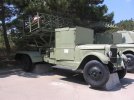
and since the Russians employed 57 Regiments and some additional small independent rocket Bns (the equivalant of 216 batteries) by the end of 1942, already, with 23% of the rocket launchers being M-30 rockets/frames, the Germans knew that they needed more artillery firepower, especially on the Bn-level, and especially since the artillery backbone of the German Army, the heavy field howitzer 18 (150 mm schwere Feldhaubitze 18) was often employed in support of Divisions, but also often held back as Korps asset.
The experience during the push on Sevastopol (during the siege of Sevastopol), where numerous strongpoints and smaller bunkers slowed down the German advance on the inner defensive belt (5 km distance to the fortress area), may have been another factor for the decision to introduce a super heavy calibre for an infantry gun.
The "15-cm schweres [heavy] Infanteriegeschütz [infantry gun] 33" or "s.IG 33", employed in the heavy section (or platoons) of a Division's IG Coy and often supporting the Regiment or specific Bns, then received the Stielgranate 42, a 300-mm overcalibre round. Stielgranate translates to stick grenade (and may make one think of the German stick hand grenades, the "potato mashers"), as the principle partially resembles the functionality of a rifle grenade, to some extent at least.
I found the following quote from Wiki to be the most understandable English explanation of the principle, so I don't have to put up the thinking cap to describe it with my own words:
"Most of the shells used by the sIG 33 were unexceptional in design, but the Stielgranate 42 was different in fundamental ways from ordinary shells. The driving rod was loaded into the muzzle so that the finned projectile remained in front of, and outside, the barrel entirely. A special charge was loaded and would propel the projectile about 1,000 metres (1,100 yd) downrange. At about 150 metres (160 yd) distance, the driving rod would separate from the projectile. Unlike other Stielgranaten, this version was not intended for anti-tank use, but rather for the demolition of strongpoints and clearing barbed-wire obstacles and minefields by blast effect."
Afaik, the accuracy was pretty ok.
The 300-mm round mounted (and ready to fire) on a 150mm IG 33:

The rather low max. range of ~1000 meters was a result of the tremendous weight of the "grenade", the round's total weight was around 90 kg (propellant charge in the rod or "stick", shell case, warhead with explosives) and a result of the relatively low amount of propellant (if compared to coastal or naval gun [ >280-mm ] ammunition using separate rounds, means : warhead + powder bag):
The muzzle velocity was 105 meters/second.
Delivering 54 kg of explosives to the target, the Stielgranate 42 contained 1.86 times more explosives than the Russian M-30/M-31 warheads (which were impressive enough, already), actually. The effect on the target area was devastating, and probably comparable to super heavy naval or coastal guns.
In general, overcalibre rounds were already used before, in particular with AT guns whose performance with existing AP or APCR rounds did not meet the minimum req. anymore (example: the 37-mm PaK, which received the Stielgranate 41), and where only a (bulbous) hollow-charge grenade could actually up the performance, as regular same-calibre HC rounds could not do the job, because the calibre (or space for the hollow-charge) was too small.
The solution with the grenades lowered such guns' max. effective ranges (200 meters on some guns, less than 400 meters on others), of course, as the grenades' velocities were very low. My guess is that you could actually see the 300-mm rounds travel through the air (like Panzerfaust or Panzerschreck rounds, with similar velocities).
Another example would be the 50-mm Pak 38, which became totally obsolete in 1943. On top of that, the production of its prime ammuntion, the Panzergranate 40 (AP), had phased out, but the gun could then still be kept in service, because it received the Stielgranate 42 (an overcalibre hollow-charge round specifically designed for the Pak 38, not to be confused with the 300-mm Stielgranate 42 for the s.IG 33) in March 1943.
Last edited:
Dave 'Arjuna' O'Connor
Panther Games Designer
- Joined
- Jul 31, 2014
- Messages
- 3,416
- Points
- 113
- Location
- Canberra, Australia
- Website
- www.panthergames.com
Hey GoodGuy I get that these are big calibre weapons but the term 'over' is relative. I assumed it referred that these were being compared to something else and I was intrigued as to what. It's not a big deal. I'm just indulging my pedantic streak. 
No. In general, if the ammunition/round does not fit the barrel, the round is classed as overcalibre.Hey GoodGuy I get that these are big calibre weapons but the term 'over' is relative.
This is also true for the conical guns used by the German Army, where the barrel's diameter next to the breech was larger than the diameter at the muzzle. The rounds for such guns had special components (metal? bands) that compressed with decreasing barrel width. This barrel design offered a way more efficient use of the expanding propellant gas, and increased the penetration power drastically, which could usually only be achieved with (way?) larger calibres (than the warhead calibre used in a conical gun), so the rounds could be lighter, too, and would still offer amazing penetration values. The first section (not conical) was still rifled, but the conical section of the barrel could become smoothbore now, which simplified the production process a lot.
If a large calibre round just uses the muzzle (of an existing lower calibre gun) as "start platform", then it is labeled "overcalibre", too.
I assumed it referred that these were being compared to something else ....
Nope.
Dave 'Arjuna' O'Connor
Panther Games Designer
- Joined
- Jul 31, 2014
- Messages
- 3,416
- Points
- 113
- Location
- Canberra, Australia
- Website
- www.panthergames.com
Ah, the penny drops! Thanks for that.
Ok, now that the penny has droppedAh, the penny drops! Thanks for that.
1) I wonder if that particular detail (AT capability for le.IG 18 and s.IG 33) had been revised.
2) Is there any chance that we'll see over-calibre rounds in the game?
Appendix:
- over-calibre rounds: 300-mm rounds with 54 kg of explosives for the Feldhaubitze 18
- max. eff. range: ~ 1000 meters
Last edited:
It would be nice if GoodGuy's mentioned AT capabilities could be included in the imminent update to the Westwall Estab .Ok, now that the penny has droppedwe can probably go back to my initial "bump"-question above:
Appendix:
- over-calibre rounds: 300-mm rounds with 54 kg of explosives for the Feldhaubitze 18
- max. eff. range: ~ 1000 meters
Appendix:
- over-calibre rounds: 300-mm rounds with 54 kg of explosives for the Feldhaubitze 18
- max. eff. range: ~ 1000 meters
Typo up there ! (It was late and brain ceased to work
It should say:
Appendix:
- over-calibre rounds: 300-mm rounds with 54 kg of explosives for the s.IG 33 .
- max. eff. range: ~ 1000 meters
Some more details about the Feldhaubitze 18 (or sFH 18):
- Muzzle velocity : 620 meters/second (according to German sources)
- Ammunition:
- Granate 19 - type: HE, Shell weight: 43.5 kg, range : 13,250 meters (13,325 according to some German sources),
- Hohlladungsgranate 39 (or "HL 39") - type: hollow charge, Shell weight: 25 kg,
- Panzergranate 39/5 - AP round (AT round, of course, also designated "schwere Panzergranate 39/5" = heavy AT round 39/5) exclusively designed and produced for the Feldhaubitze 18, afaik (can't think of any other gun of that calibre with AT capability ..... with one exception: there were two Flak 150 mm prototypes, which could have served in a dual role, I guess),
- sidenote: the shells fired with the 150 mm prototype FLAK guns could reach altitudes of 10,200 and 10,400 meters - turbo-charged B-17G's service ceiling: 10,850 meters. Tests of these 2 guns (one from Krupp, one from Rheinmetall) were very successful (devastating effects on test targets/drones), but serial production did not materialize.
- Granate 19 Be ("Be" = "Beton" = concrete), anti-concrete shell
- Improved barrel/recoil version:
- 15 cm sFH 18M (M = "Mündungsbremse" = muzzle brake), version with a muzzle brake and recoil modification, so that it could fire a "7th" and "8th" cartridge to improve range, pretty much in the same manner as with the le.IG 18's "6th cartridge" described above. It turned out that the recoil system suffered of extreme wear when those extended range cartridges were used ....
- too heavy to be drawn by horses now, for motorized units only.
- Improved ammunition (desperate attempts to up the range, which was inferior to the range of Russian arty pieces):
- Granate 19 Be rot ("rot" = red), improved anti-concrete shell
- Granate 19 FES, reduced weight to improve range ("sintered iron driving band")
- Granate 36 FES, reduced weight to improve range (thinner casing walls, "sintered iron driving band", whatever that means, source: Ian Hogg. I could imagine that the bands created a slight overcalibre and that they got compressed when traveling through the barrel, thus upping the muzzle velocity)
- Granate R 19 FES, rocket-assisted shell with special charge for the sFH 18M, range: 18,200 meters
Last edited:
simovitch
Member
Regarding AP for the German infantry guns. Was this ammo commonly used on the Western front in 1944-1945? I hesitate to add these capabilities if they were not standard issue. From what I have read about in the Ardennes, these IG crews were trained to stay back a little behind the front and provide HE infantry support. They were also mainly foot-bound after they reached the front and probably didn't want to lug around extra AP ammo when the AT sections were responsible for that. What do you think?
Regarding AP for the German infantry guns.
They never received AP rounds, but HEAT (hollow-charge) rounds.
The HEAT (german: HL = Hohlladung) rounds for the infantry guns were used from the point in the war where they were first issued until the end of the war, as they were standard issue. Despite being actually outdated, the Germans kept producing le.IG 18 guns, and they were employed in IG Coys, Recon Bns and Cavalry Bns, serving as close support weapons (with HE, the main purpose) AND as antitank weapons.Was this ammo commonly used on the Western front in 1944-1945?
I am not sure about the typical loadout per infantry gun, but it's pretty obvious that an IG ammo stock contained a certain amount of HL-grenades (HEAT).
A short study published in 1963 in the "Allgemeine schweizerische Militärzeitschrift" (Swiss Army military magazine) and authored by Major Gerhard Donat, Vienna (Austria), outlined/analyzed the ammunition expenditure for campaigns and major battles from 1939 to around 1943, but even more interesting, also detailed the FIRST LOADOUT a given gun gun had to receive (as of 1st of May 1944, according to Wehrmacht ordnance, see scan below).
The Wehrmacht conducted extensive studies that examined ammo expenditure under various conditions, which was important for planning of logistics and production. After the battle of Sevastopol the Germans could start to establish base expenditure figures for various conditions, so they separated expenditures during attacks and defensive operations for the following conditions (rough translation):
Attack
- a) progressing well
- b) difficult, tedious
- c) against fortress (Sevastopol)
- a) at calm Front
- b) during major offensives
The first loadout (as of 1st of May 1944):
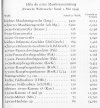
The first loadout for a (single) light infantry gun amounted to 189 rounds (these were, as I outlined either here or in the Matrix forums, kept on the nearby ammunitions wagon, and the rest on the supply columns cars/wagons and at depots in the rear). I would have to invest some 60 or 80 USD and obtain a couple of German magazines (1960s) and one or another small book (1990) - from the publisher where Jentz used to publish his shorter papers - covering the infantry guns, in order to establish an exact amount, but it is safe to say that a certain amount of supply and depot space was reserved for maintaining the AT capability, means for HEAT rounds.
Sidenote: expenditure figures of the Artillery-Regiment 125 for the defensive battles at the Mius river (March 1942 - June 1942) and the follwing attack (July, attacking towards Caucasus in August and follwing battles in September), and then the readjustment (improving) of frontlines and the following defensive battles in November/December 1942 (Chir river battles?) are particularly interesting, as they are based on exact counts (posted in the unit's war diary) performed by that Artillery-Regiment (125), which didn't just list the rounds fired at Russian positions, but also Russan shells fired in the Regiment's sector.
There are also exact breakdowns (in percent) showing the times of highest activity of the Russian artillery, where you can see, that in April - June 1942 Russian artillery would usually conduct fire missions in the afternoon and evening and fall back to sporadic harrassment/inderdiction fire missions for the rest of the day/night or even complete silence. The study also stresses that Russian firing methods were inferior to the more effective German methods, which the Russians tried to compensate with higher expenditures. For instance, from April 15 to May 14 (1942), the Regiment fired 396 rounds with light and heavy field guns, while the Russians fired 1472 rounds. From May 15 to June 14, the Russians fired 3051 rounds, while the Regiment fired 998 rounds. During the first period, the Russians fired 3.71 times more rounds, and 3.06 times more during the second period, with the highest activity of the Russian artillery always occuring between 3 p.m. and 5 p.m. (April/May: 23%, May/June: 16.4%) and between 5 p.m. - 7 p.m. (April/May: 24%, May/June: 25.4%).
Back to the infantry guns:
The following link leads to a very detailed article authored by a German (living in the US), Thorsten Herbes, whose grandfather had served in the 352. Volksgrenadier-Division. He blends in personal accounts from his grandfather, Erich Michely (died in 2011), an NCO who led an IG platoon during the Battle of the Bulge, after he had served in Russia (2 deployments, wounded 1 or 2 times):
http://gottmituns.net/2012/12/22/me...oldier-during-the-battle-of-the-bulge-194445/
Erich Michely said:As the advance troops of the 915th continued to wait near Bastendorf, Michely and his men made steady progress toward them. “We often moved cross-country, following the infantry and providing fire support where needed. I think we were also afraid to stay on the roads for too long, for fear of American [P-38] Lightnings.” Hindered by the rough terrain, the men were often forced to assist the horses in moving the guns. Many of the details of 8/915 route and events along the way have long left Michely’s memory, but several anecdotal stories remain. “The infantry at the front of the column needed artillery support and we had to get our guns up the hill to help them. The hill was so steep that we had to turn the guns around, with their barrels facing forward, hook all the horses to one gun at a time and push it up the slope ourselves. Eventually, we managed to get all four of them up the hill.” Michely continues: “I believe it was near Tandel where we came across two US tanks, unaware of our presence. We were looking down at them from an elevated position and our guns knocked both of them out. I don’t recall if any of the crew managed to get out.”[37] Given the horse-drawn means of transportation, Michely’s company always seemed to lag behind the advance infantry troops and thus avoided much of the combat they faced. “We maybe fired a dozen rounds or so throughout the entire Ardennes campaign.”
Herbes assumes that Michely's platoon was equipped with Infanterie-Geschütz 42 guns. The IG 42 was developed by Krupp after the French campaign had ended (1940) and the gun was supposed to replace the le.IG 18. With a weight of 590 kg, the IG 42 was considerably heavier than the horse-drawn version of the le.IG 18 (405 kg in transport mode, 400 kg when deployed), and still somewhat heavier than the le.IG 18 version with rubber tires for motorized units (515 kg in transport mode, 570 kg when deployed), but its barrel was 178.8 cm long, the muzzle velocity clearly higher (280 meters/second) and the max. range considerably higher (4800 meters). The designers already envisioned a dual role, so they added a feature that was unseen before on infantry guns: the gun could be traversed 78 degrees. For comparison: The le.IG 18's barrel could be traversed 11 degrees only, but the max elevation was 75.3 degrees. The IG 42's barrel could only be elevated to 32 degrees. This made high-angle fire on say trenches impossible, but the 75mm HE round could still blast off earth walls (protecting trenches) with a thickness of up to 1 meter, so the gun was capable to serve in its planned (dual) role.
Since the production of the HEAT (HL) round for the le.IG 18 had started already, the Wehrmacht canceled the production, but picked up the project in 1944 again (because the production of one le.IG 18 involved 1200 man-hours, some parts needed for the IG 42 could be produced in a shorter time, but also because gun losses had to be replaced) and ordered 1450 IG 42 guns, with the first batch issued to frontline units in October 1944. Michely reports about flat tires, which would be odd for le.IG 18s, as his unit clearly operated horse-drawn guns, and as le.IG 18 guns with rubber tires were usually issued to motorized units, only.
In turn, most - if not all - IG 42 guns were issued with either solid rubber tires or with air-filled rubber tires, so the author's assumption that Michely commanded a IG 42 platoon may actually be correct.
Also, Michely reports that his "unit" (Bn/Regiment/Division ???) had been equipped with Sturmgewehr 44 assault rifles, so it seems to be a fair conclusion that they also got some of the relatively new Infantry guns (either Infanteriegeschütz 42 or Infanteriegeschütz 37, see pictures below).
EDIT : Despite the gun looking like a PaK (AT) gun, its pretty low velocity made it impractical to fire AP rounds with it, as AP shells would have lacked the kinetic energy to penetrate. The only solution for the dual-role was to equip it with HEAT rounds.
These guns were not to serve as dedicated AT guns, but since the 88mm PaK 43 or the PaK 43/41 were employed in Panzerjäger units, as Schwerpunkt defense, and even often held back as Korps reserve, the AT capabilities of the light infantry guns were desperately needed.
The effective AT range of a le.IG 18 (with a pretty short barrel) was probably 300 meters and below, as anything above that range must have been a curved trajectory (hard to aim/calculate the shot). With the comparably long barrel of an IG 42 or IG 37, I could imagine that the max effective AT range was somewhat higher, but I do not have exact numbers. The le.IG 18's field manual from 1940 stresses that enemy armored cars can be engaged (with HE rounds) at ranges of ~300 meters or below, and that a forward defensive perimeter, road block or "hold up" should be established at around 300 meters, so that the le.IG 18 can engage with a flat (trajectory) shot. The HEAT rounds for the gun did not exist yet when that version of the manual was printed.
Infanteriegeschütz 42 with solid rubber tires:
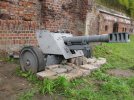
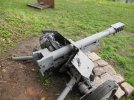
IG 42 with air-filled tires:

The Infanteriegeschütz 37 (~1304 guns were still in service at the end of the war) was orginally introduced as a stop-gap measure (easier to produce, less parts, either mounted on a PaK 36 carriage or on captured Russian carriages) and designated 75mm-PaK 37, but it was in fact a mix of an infantry gun and an AT gun, and - afaik - used the barrels that were originally designed for the IG 42 (traverse: 60 degrees). It never received AP rounds, as the muzzle velocity (280 m/sec with HE : max range 5150 meters - as the barrel was a tick longer than the IG 42's barrel, 395 meters/sec with HEAT) was too low, so it received HEAT rounds. Since the gun fired the same rounds as the le.IG 18, the gun was re-classed in May 1944 and then designated Infanteriegeschütz 37. The Germans started to issue the first batch of guns to troops in June 1944:
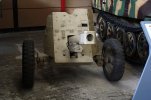
They were also mainly foot-bound after they reached the front and probably didn't want to lug around extra AP ammo when the AT sections were responsible for that. What do you think?
Vital parts of the first loadout were always kept with the marching column, the rest was further behind.
In Michely's anecdote, the gun crews had "parked" the horses towing the ammo wagons right on the street (as they had not deployed yet), when they got surprised by the US attack in Merzig.
SIDENOTE: The personal account of Generalmajor Erich Otto Schmidt, the commander of the 352. Volksgrenadier-Division, regarding the equipment and combat readyness:
According to Generalmajor Erich Otto Schmidt, Commander of the 352nd VGD: “I took over the division in October 1944. We continued to train until 15 November when we were moved to Bitburg, in the Eifel region, where we continued to train and supplement our equipment. Near the end of November, the division took over a section of the Westwall between Vianden and Echternach. 48 hours prior to the attack on 16 December, the division was led to its jumping off points between Roth and Wallendorf.”[12] Generalmajor Schmidt continues: “The division was formed and equipped according to standard specifications for Volksgrenadier divisions, with Ersatz troops drawn from navy and air force ranks.”[13] Prior to the attack, Schmidt rated his troops:[14]
Enlisted Personnel: Age 23 -30, not enough training, no land or combat experience, not seen action. Full strength.
Non-commissioned Officers: Mostly navy troops, most lack front experience. 75% strength.
Officers: Varied front experience. Full strength.
Infantry: Good fighting spirit in Regiments 914 and 915. Lacks training and front experience.
Equipment: Mostly complete. Missing 35% of radios for fire direction, 30% of assault guns, 25% assault rifles.
In general terms, the 352nd VGD was well equipped for 1944 but lacked in experience. The 352nd was made up of three infantry regiments (914th, 915th and 916th), an artillery regiment, one cavalry battalion, one anti-tank battalion as well as anti-aircraft, engineer and signal battalions. At full strength, the division made up about 13,000 troops.[15] Unteroffizier Erich Michely, veteran of two tours of duty on the Eastern Front, was assigned to 8th (Heavy) Company, 2nd Battalion, 915th Volksgrenadier Regiment, as a light infantry gun crew leader.
Last edited:
Similar threads
- Replies
- 5
- Views
- 1K